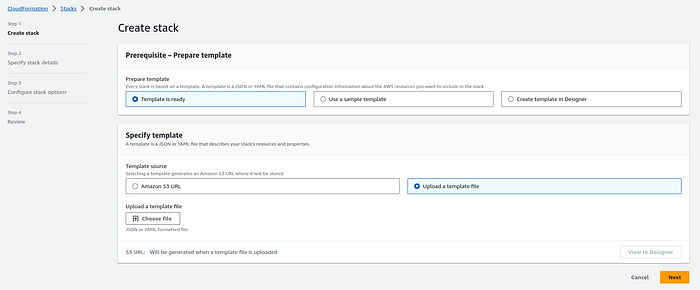AWS CloudFormation Template -AWS Lambda Layer
 Mahira Technology Private Limited
Mahira Technology Private Limited

Introduction:-
In modern cloud computing environments, deploying and managing serverless applications is becoming increasingly prevalent due to its scalability and cost-effectiveness. #AWS CloudFormation, a service offered by #Amazon Web Services (AWS), empowers users to define and provision infrastructure resources in a structured and repeatable manner. One essential component of serverless applications is #Lambda layers, which allow code and libraries to be shared across multiple #Lambda functions, promoting code reuse and maintainability.
#AWS CloudFormation template written in #YAML format. CloudFormation is a service provided by #AWS that allows you to define and provision infrastructure resources in a declarative manner. This template is specifically designed to create an #AWS Lambda layer. Let me break down the key sections and components of this template:
#AWSTemplateFormatVersion: Specifies the CloudFormation template version being used.
Transform: Specifies that the template uses the AWS Serverless Application Model (AWS SAM) for defining #serverless resources.
Description: A brief description of the #CloudFormation template.
Parameters: This section defines the input parameters that users can provide when deploying the stack. These parameters allow customization of the deployment.
EnvironmentName: A string parameter for specifying the environment name (e.g., "dev" or "production").LambdaLayerName: A string parameter for specifying the name of the Lambda layer.CodeS3Bucket: A string parameter for specifying the S3 bucket where the #Lambda artifact is stored.CodeS3Key: A string parameter for specifying the #S3 key for the #Lambda artifact.
5. Mappings and Conditions: These sections are currently empty and can be used for more advanced configuration if needed.
6. Resources: This section defines the #AWS resources to be created. In this case, it creates an #AWS Lambda layer named BaseLine14xLambdaLayer. Key properties of this resource include:
Type: Specifies the resource type asAWS::Lambda::LayerVersion.CompatibleRuntimes: Specifies the runtime compatibility for the Lambda layer (nodejs14.x in this case).Content: Specifies the #S3 bucket and key where the Lambda layer content (code) is located.Description: Describes the #Lambda layer with a combination of theEnvironmentNameandLambdaLayerName.LayerName: Specifies the name of the #Lambda layer.LicenseInfo: Specifies the license information for the layer (MIT in this case).
7. Outputs: This section defines the stack outputs, which are values that can be used after the stack is deployed. It exports the ARN of the #Lambda layer as an output with a name derived from the EnvironmentName and LambdaLayerName parameters.
Users can deploy this #CloudFormation template by providing values for the specified parameters, and it will create the specified #AWS Lambda layer with the specified configuration.
Deployment Steps
Follow these steps to upload and create the #CloudFormation stack using the #AWS Management Console:
- Sign in to the #AWS Management Console: Log in to your AWS account if you haven’t already.
2. Navigate to #CloudFormation: Go to the #AWS CloudFormation service from the #AWS Management Console.
3. Click the “Create stack” button.
4. Upload the CloudFormation template file (YAML).

Yaml file :
AWSTemplateFormatVersion: "2010-09-09"
Transform: AWS::Serverless-2016-10-31
Description: Lambda layer
Parameters:
EnvironmentName:
Description: Environment name for the application
Type: String
ConstraintDescription: Specify either dev or production
LambdaLayerName:
Description: Application Name
Type: String
CodeS3Bucket:
Description: S3 Bucket in which the artifacts are stored
Type: String
MinLength: 3
CodeS3Key:
Description: S3 Key for the lambda artifact
Type: String
MinLength: 3
Mappings: {}
Conditions: {}
Resources:
BaseLine14xLambdaLayer:
Type: AWS::Lambda::LayerVersion
Properties:
CompatibleRuntimes:
- nodejs14.x
Content:
S3Bucket: !Ref CodeS3Bucket
S3Key: !Ref CodeS3Key
Description: !Sub ${EnvironmentName}-${LambdaLayerName}
LayerName: !Sub ${EnvironmentName}-${LambdaLayerName}
LicenseInfo: MIT
Outputs:
BaseLine14xLambdaLayerArn:
Description: Lambda layer arn.
Value: !Ref BaseLine14xLambdaLayer
Export:
Name: !Sub '${EnvironmentName}-${LambdaLayerName}-arn'
5. Specify Stack Details:
Enter a Stack name for your deployment.
Provide parameter values as needed.
Review and acknowledge the capabilities .
You can set additional stack options or tags if necessary.
6. Review and Create:
Review the stack details and configuration.
Click “Create stack” to initiate the deployment.
7. Monitor Stack Creation:
The CloudFormation stack creation process will begin.
Monitor the stack events in the AWS Management Console.
Conclusion
AWS #CloudFormation template serves as a valuable tool for streamlining the creation and management of #Lambda layers in #AWS serverless applications. By offering a structured and parameterized approach, it allows users to customize the #Lambda layer’s environment name, name, and associated #S3 artifacts. This template promotes best practices in serverless development by enabling code reuse and separation of concerns, ultimately leading to more maintainable and efficient serverless applications.
Subscribe to my newsletter
Read articles from Mahira Technology Private Limited directly inside your inbox. Subscribe to the newsletter, and don't miss out.
Written by

Mahira Technology Private Limited
Mahira Technology Private Limited
A leading tech consulting firm specializing in innovative solutions. Experts in cloud, DevOps, automation, data analytics & more. Trusted technology partner.